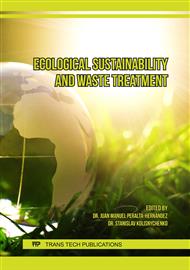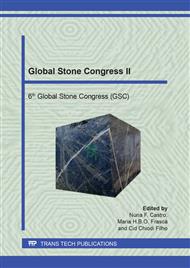[1]
N. Careddu, 2019. Dimension stones in the circular economy world. Resources Policy 60 (2019) 243–245.
DOI: 10.1016/j.resourpol.2019.01.012
Google Scholar
[2]
C. Montani, XXIX World Marble and Stones Report 2018. Aldus Casa di Edizioni, Carrara (2018).
DOI: 10.1007/s13563-019-00183-6
Google Scholar
[3]
European Commission, 2011. Report from the commission to the European parliament, the council, the European economic and social committee and the committee of the regions - on the Thematic Strategy on the Prevention and Recycling of Waste. COM(2011) 13 final. European Commision - Brussels, 19.1.(2011).
DOI: 10.54648/eerr1996017
Google Scholar
[4]
DIRECTIVE 2006/21/EC OF THE EUROPEAN PARLIAMENT AND OF THE COUNCIL of 15 March 2006 on the management of waste from extractive industries and amending Directive 2004/35/EC.
Google Scholar
[5]
DIRECTIVE 2008/98/EC OF THE EUROPEAN PARLIAMENT AND OF THE COUNCIL of 19 November 2008 on waste and repealing certain Directives.
Google Scholar
[6]
http://ec.europa.eu/environment/waste/framework/framework_directive.htm [viewed March 1, 2019].
Google Scholar
[7]
N. Careddu, G.A. Dino, S.W. Danielsen, R. Přikryl, 2018. Raw materials associated with extractive industry: An overview. Resources Policy, 59 (2018) 1-6.
DOI: 10.1016/j.resourpol.2018.09.014
Google Scholar
[8]
OSNET Editions vol. 7, Optimising quarrying techniques and practices, edited by N. Terezopoulos, I. Paspaliaris, Athens (2004).
Google Scholar
[9]
N. Careddu, G. Siotto, R. Siotto, G. Tilocca, 2013. From landfill to water, land and life: the creation of the Centre for stone materials aimed at secondary processing. Resources Policy 38 (2013) 258– 265.
DOI: 10.1016/j.resourpol.2013.05.001
Google Scholar
[10]
N. Careddu, G.A. Dino, 2016. Reuse of residual sludge from stone processing: differences and similarities between sludge coming from carbonate and silicate stones—Italian experiences. Environ Earth Sci (2016) 75:1075. DOI 10.1007/s12665-016-5865-1.
DOI: 10.1007/s12665-016-5865-1
Google Scholar
[11]
G. Marras, G. Siotto, J.L. Parra, N. Careddu, 2010b. Potential applications of waste material deriving from marble processing plants. Proc. 7th International Marble and Natural Stones Congress of Turkey (Mersem VII), 14-15 October 2010, Afyonkarahisar, Turkey. Pagg. 55-61. Ed. M. Ersoy, M.Y. Çelik, L. Yeşilkaya. ISBN: 978-605-01-0023-5.
Google Scholar
[12]
G. Marras, N. Careddu, G. Siotto, 2017. Filler calcium carbonate industrial applications: the way for enhancing and reusing marble slurry. In Italian Journal of Engineering Geology and Environment, Special Issue 2 (2017) © Sapienza Università Editrice, Roma.
Google Scholar
[13]
G. Marras, N. Careddu, C. Internicola, G. Siotto, 2010. Recovery and reuse of marble powder by-product. In: Proceedings of the Global Stone Congress 2010. 02 - 05 March 2010, Alicante (Spain).
Google Scholar
[14]
G. Marras, 2011. Recovery and valuation of ultrafine marble dust contained in waste slurries deriving from carbonatic natural stones processing plants. Thesis of the Geoengineering and Environmental Technologies Ph.D., University of Cagliari, Italy.
Google Scholar
[15]
G. Marras, A. Bortolussi, R. Peretti, N. Careddu, 2017. Characterization methodology for re-using marble slurry in industrial applications. Energy Procedia, Volume 125, September 2017, Pages 656–665. https://doi.org/10.1016/j.egypro.2017.08.277.
DOI: 10.1016/j.egypro.2017.08.277
Google Scholar
[16]
G. Marras, N. Careddu, 2018. Sustainable reuse of marble sludge in tyre mixtures. In Resources Policy, 59 (2018), pp.77-84.
DOI: 10.1016/j.resourpol.2017.11.009
Google Scholar
[17]
ASTM D5289 – 12 Standard Test Method for Rubber Property – Vulcanization Using Rotorless Cure Meters.
DOI: 10.1520/d5289-07
Google Scholar
[18]
ASTM D792 – 13 – Standard Test Methods for Density and Specific Gravity (Relative Density) of Plastics by Displacement.
Google Scholar
[19]
ASTM D2240 – 15 Test Method for Rubber Property—Durometer Hardness.
Google Scholar
[20]
DIN 53512-2000 Determining the rebound resilience of rubber.
Google Scholar
[21]
ASTM D412 – 15a Standard Test Methods for Vulcanized Rubber and Thermoplastic Elastomers – Tension.
Google Scholar



